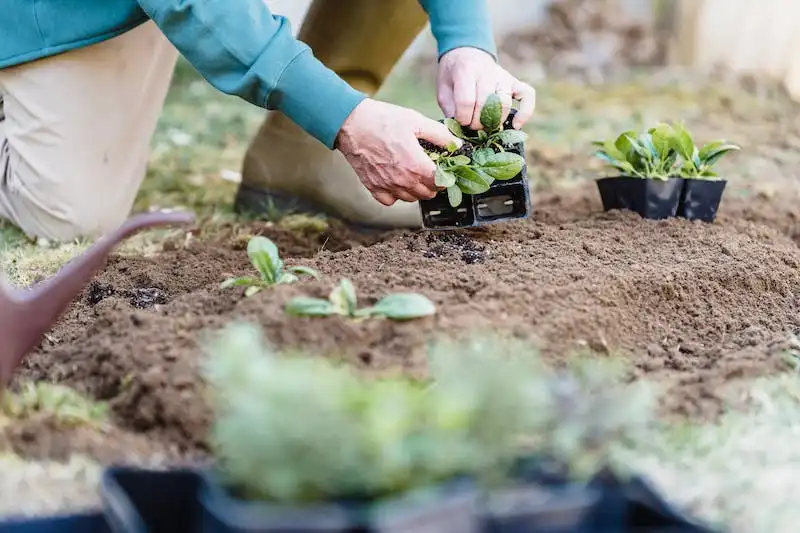Planting oaks can be a rewarding and fulfilling experience. Oaks are majestic trees that can grow to be very tall with a wide trunk. They are also known for their long lifespan, often living for hundreds of years. Planting young oak trees can be an exciting venture, as you watch them grow and mature over time.
Planting oak trees can be done in various ways. You can start by collecting acorns and planting them in small holes. This method allows you to plant many trees quickly – and it’s also a great way to propagate more oaks. Another option is to purchase young oak trees from a nursery or plant them directly in your yard. Whichever method you choose, it’s important to ensure that the trees are well-planted and protected.
When planting oak trees, it’s essential to provide proper care and maintenance. Oaks prefer to grow in well-drained soil, so it’s important to prepare the planting holes by loosening the soil and adding organic matter such as peat or sawdust. This will help the roots establish and promote healthy growth. Additionally, irrigating the newly planted trees regularly is crucial, especially during the first couple of weeks after planting.
One of the benefits of planting oaks is that they are resistant to many pests and diseases. However, oaks can be susceptible to rodents, deer, and other animals that may damage the young trees. Taking measures to protect them, such as using tree guards or enclosing the planting area, can help ensure their survival.
In conclusion, planting oaks is a great way to contribute to the environment and create a beautiful landscape. Whether you choose to collect acorns and grow your own trees or purchase young oak trees, taking care of them is essential for their growth and survival. With proper care and maintenance, your oak trees will soon thrive and become a cherished part of your garden.
How to Plant an Acorn and Grow an Oak Tree
If you want to learn how to grow an oak tree, the first step is to plant an acorn. Planting an acorn and growing an oak tree may seem like a daunting task, but with some care and patience, you can successfully grow your own oak tree. There are many benefits to planting oaks, including their long lifespan, beautiful appearance, and their ability to provide shade. Here’s a step-by-step guide on how to plant an acorn and grow an oak tree.
- Collect acorns during the fall season when they have fallen from the oak trees. Look for healthy acorns that are free from cracks or damage.
- Soak the collected acorns in water for a few minutes. This will help to remove any dirt or debris and also simulate the winter conditions that oak acorns need in order to grow.
- After soaking, fill a container with potting soil or sawdust and plant the acorns about an inch deep. Make sure to leave some space between each acorn.
- Water the planted acorns regularly, keeping the soil moist but not soaked. You can use a spray bottle or a small watering can for this.
- Place the container in a cool, dark place like a refrigerator or basement. This will simulate the winter conditions that oak acorns need for germination.
- After a few weeks, check for signs of growth. If you see small shoots emerging from the acorns, that’s a good sign! It means the acorns have started to germinate.
- Once the shoots have grown to about 3-4 inches tall, you can transplant the young oak trees into a larger container or your garden. Make sure to choose a spot that receives plenty of sunlight.
- When transplanting, dig a hole that is twice as wide as the root-ball of the oak tree and deep enough to accommodate the roots. Gently place the oak tree into the hole and backfill with soil, pressing it down firmly.
- Water the newly planted oak tree thoroughly and apply a layer of mulch around the base to help retain moisture and suppress weed growth.
- Continue to water the oak tree regularly, especially during dry periods, and monitor its growth. Oaks are usually slow-growing, but with proper care, they can grow into majestic, large trees.
- To protect your young oak tree from deer and other animals, consider using fences or deterrents. Deer can be particularly destructive to young oak trees, so it’s important to take precautions.
With some time and effort, you can successfully plant an acorn and grow your own oak tree. Soon, you’ll be able to enjoy the beauty and benefits of having an oak tree in your garden or landscape!
Tip
When planting oak trees, it’simportant to follow a few tips to ensure successful growth. Here are sometips to keep in mind:
- Choose the right planting location: Oaks prefer sunny areas with well-drained soil. Find a spot that provides enough space for the oak to grow and develop.
- Prepare the planting hole: Dig a hole that is two to three times wider than the root ball of the young oak tree. This will give the roots enough room to spread out and establish a strong foundation.
- Collect and plant acorns: If you have oak trees nearby, collect acorns in the fall and plant them in pots. Keep them in a refrigerator for several weeks to simulate winter conditions before planting them in the spring.
- Protect your newly planted oaks: Install fences or other barriers around the young trees to keep deer and rodents away. This will help protect the plants while they establish themselves.
- Water regularly: After planting, water the oak tree deeply and regularly until it becomes established. Use an irrigation system or water by hand, making sure to water deeply to encourage deep root growth.
- Use mulch: Apply a layer of mulch around the base of the oak tree, but make sure to leave space around the trunk to prevent rot. Mulch helps retain moisture, suppresses weeds, and insulates roots.
- Propagate oaks from cuttings: If you want to propagate oaks, you can try taking stem cuttings in late summer or early fall. Dip the cut ends in rooting hormone and plant them in a mixture of peat and sand.
- Learn about oak tree care: Educate yourself about various aspects of oak tree care, such as pruning, fertilizing, and pest control. A little research will go a long way in ensuring the health and longevity of your oaks.
Byfollowing these tips, you can plant and grow healthy oak trees in your garden or landscape. Oaks are beautiful and long-living trees that have many benefits for the environment, so it’s worth investing the time and effort to ensure their successful establishment and growth.
When and How to Collect Acorns
If you want to learn how to collect acorns, there are several steps you can follow to ensure successful propagation of your oak trees. The best time to collect acorns is in the fall, after they have fallen from the trees. Look for acorns that are still greenish-blue or brown in color, as these are more likely to be viable for planting.
Before planting the acorns, it is recommended to soak them in water for a few days. This will help to remove any toxins and improve the chances of successful germination. Some gardeners also recommend stratifying the acorns by placing them in a sealed container with moist sawdust or peat moss in the refrigerator for several weeks. This mimics the natural winter conditions that the acorns would experience in the ground, and can help to break their dormancy.
When collecting acorns, it’s important to be aware of the source. Acorns from large, healthy trees will likely produce the best seedlings. Additionally, check for signs of damage or disease, as these acorns may not grow or could pass on problems to the young trees. It is also a good idea to avoid collecting acorns from areas where deer are known to frequent, as they often eat acorns and could have spread diseases through their feces.
- Collect acorns from healthy trees
- Look for greenish-blue or brown acorns
- Soak acorns in water for a few days
- Stratify acorns in the refrigerator for several weeks
- Avoid collecting acorns from deer frequented areas
- Check for signs of damage or disease
Once you have collected your acorns and prepared them for planting, you can choose to either sow them directly in the ground or start them in pots. If planting in the ground, dig holes that are just wide enough and deep enough to accommodate the acorn and its root. If planting in pots, fill them with a well-draining potting mix, place the acorns about an inch deep, and water lightly.
Regardless of how you choose to plant, it’s important to protect your young oak trees from rodents and other animals. Fencing and wire cages can be used to keep them safe. It’s also important to provide irrigation for the newly planted acorns, as they require consistent moisture to grow.
With proper care and patience, your collected acorns will begin to grow into young oak trees. Keep an eye on their growth and make sure to provide support if they become root-bound. When the trees reach about three years old, they can be planted in their permanent locations and allowed to grow freely.
Collecting and propagating acorns can be a rewarding experience for any gardener. Not only will you be helping to preserve and grow beautiful oak trees, but you will also be able to enjoy the many benefits they provide, like shade, aesthetic appeal, and wildlife habitat. So why not spend some time this fall collecting acorns and getting started on your own oak tree planting journey?
Getting Started
Planting oak trees from acorns is a rewarding and fulfilling process, but it requires some knowledge and preparation. Here are some steps to help you get started:
- Collecting Acorns: When the acorns are ripe, usually in late summer or early fall, you can collect them from the ground. Choose acorns that are large, firm, and free from signs of damage or disease.
- Preparing the Acorns: To improve germination rates, you can soak the acorns in water for 24-48 hours. This will help to remove any tannins that may inhibit growth. Some people also store acorns in the refrigerator for several weeks to simulate winter conditions.
- Planting the Acorns: When you’re ready to plant, find a suitable location in your garden or a protected area. Oaks prefer well-drained soil, so make sure the planting area is free from standing water. Dig holes that are deep enough to accommodate the young oak trees’ roots.
- Caring for the Young Oaks: After planting, water the newly planted acorns regularly, especially during dry periods. Mulch around the base of the trees with peat moss or sawdust to help retain moisture. Protect the young oaks from rodents and deer by using tree guards or fencing.
- Watching the Growth: It won’t take long for your oak trees to grow. Soon, you’ll see the first signs of growth – small green leaves emerging from the ground. As the trees grow, you may need to provide additional irrigation and care.
Planting oak trees is a long-term commitment, as they can live for hundreds of years. However, the reward of seeing your trees grow and flourish is worth the effort. Just remember to be patient and allow nature to take its course.




